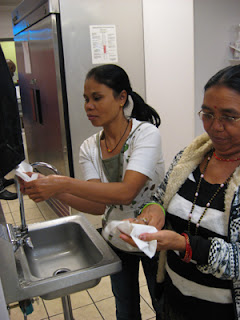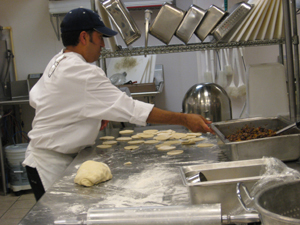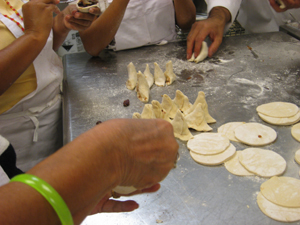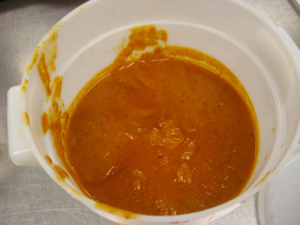LEARNING ENGLISH THROUGH CULTURAL VALUES AND REFUGEE STRENGTHS

THIS PHOTO DOCUMENTATION records Bhutanese women who took part in DATS MashUp, an event I organized that matched refugees and professional chefs in a collaborative cooking experience. Their challenge was to overcome language and communication obstacles and create recipes that combined the knowledge of both. Finally, they would present their results to a live audience.
This documentation shows how refugees who struggle with English quickly overcome communication problems when they have an opportunity to share something of value from their culture (Nepali food), learn something of compelling interest to them (American cooking practice, work in a professional kitchen, related job training, opportunities to travel to a new city, chances to practice English), have the ability to express their knowledge through words and actions (kinesthetic experiences — “learning by doing”), and see their knowledge and experience respected and validated by Americans (through the formal presentation at DATS which included samplings by Americans of their recipes).
These photos can be used by a teacher in the traditional classroom as follow-up, review and reinforcement. At the end of this page are photos of kitchen implements and equipment the women used. These photos can be used by the women to create a PhotoVoice learning and empowering document. They can form the basis of a training manual for developing job skills in the Nepali population.
Through Narayan Khadka and Dian Nussbaum we met Nepali women interested in participating in a cooking collaborative. Women were asked to bring ingredients and foods they liked to cook with. This started a lively round of conversation. We learned something about traditional Nepali cooking and the names of ingredients.
SETTING A COMMON GOAL
SECOND DAY: WORK
Here the team arrives at the Second Harvest Food Bank located in Winston-Salem. I explained to the team the exact time at which I'd arrive to pick them up and drive them from their apartment complex in Greensboro so we could make our 11:00 am meeting. Because we want to emphasize cultural values first and foremost, we respect the cup of morning coffee offered us, the lengthy neighborly conversation that goes on before we all get into the car, and other trust-building activities inherent in our approach to cultural learning and sharing.
PEELING
Here the women are shown how to cut the purple sweet potatoes. Chef Jeff Bacon also converses with the women and Chef Harry also lends a hand. Some practice professional cutting technique after observing the chefs' own work. The other chefs help set up the womens' work stations and do clean up. Later, some of the women help in the clean up tasks.
CURRY
DOUGH
SINGARA
COOK
PUDDING
THIRD DAY: FRYING
PLATE
VOCABULARY REVIEW

The women got out of cramped apartments and did something familiar from their old lives (Mental Health). They engaged in employment-related skill building (Job Training). They engaged in true acculturation, teaching their Nepali language and traditions and learning American words and customs. They practiced English. They socialized with Americans. They felt confident and asked to continue training (Empowerment). They learned by doing and retained more information (Kinesthetic Learning).
THIS PHOTO DOCUMENTATION records Bhutanese women who took part in DATS MashUp, an event I organized that matched refugees and professional chefs in a collaborative cooking experience. Their challenge was to overcome language and communication obstacles and create recipes that combined the knowledge of both. Finally, they would present their results to a live audience.
This documentation shows how refugees who struggle with English quickly overcome communication problems when they have an opportunity to share something of value from their culture (Nepali food), learn something of compelling interest to them (American cooking practice, work in a professional kitchen, related job training, opportunities to travel to a new city, chances to practice English), have the ability to express their knowledge through words and actions (kinesthetic experiences — “learning by doing”), and see their knowledge and experience respected and validated by Americans (through the formal presentation at DATS which included samplings by Americans of their recipes).
These photos can be used by a teacher in the traditional classroom as follow-up, review and reinforcement. At the end of this page are photos of kitchen implements and equipment the women used. These photos can be used by the women to create a PhotoVoice learning and empowering document. They can form the basis of a training manual for developing job skills in the Nepali population.
FIRST DAY: MEETING AND SHARING
Through Narayan Khadka and Dian Nussbaum we met Nepali women interested in participating in a cooking collaborative. Women were asked to bring ingredients and foods they liked to cook with. This started a lively round of conversation. We learned something about traditional Nepali cooking and the names of ingredients.
________________
SETTING A COMMON GOAL
Roshan is a Nepali immigrant and US citizen who has worked as a professional cook throughout the world. He is sympathetic to the refugees and respectful to the women, some of whom arrived only months ago. He explains the high standards he expects and the opportunity the collaboration project represents. Most importantly, he explains the goal they all must agree to work towards. In the end, of the four women in the room, two drop out and the next day, a new member joins.
________________SECOND DAY: WORK
Here the team arrives at the Second Harvest Food Bank located in Winston-Salem. I explained to the team the exact time at which I'd arrive to pick them up and drive them from their apartment complex in Greensboro so we could make our 11:00 am meeting. Because we want to emphasize cultural values first and foremost, we respect the cup of morning coffee offered us, the lengthy neighborly conversation that goes on before we all get into the car, and other trust-building activities inherent in our approach to cultural learning and sharing.
________________
SANITATION
SANITATION
The women met Chef Pam who would assist Roshan. They knew they would work with a purple sweet potato as stipulated by collaboration rules. Although they had not cooked with the purple sweet potato, they were familiar with the native Nepali cultivar which had white flesh. They learn about hygiene and cleanliness in the kitchen. They learn the English apron and tie and tie in the front and tie in the back.
________________PEELING
Roshan shows by example. Notice the communal activity. The peelers take some getting used to and the women eventually master the technique of keeping the blade flat on the potato surface and using single, sweeping gestures. When a potato falls to the floor a woman is corrected and told to throw it away. When another's hands touch the floor, she is told she must wash her hands. Most of these activities are familiar to the women, mothers all, who certainly know how to prep and cook. But the context is different, challenging and engaging. This exercise introduces English words such as peel and skin.
________________
CUTTING
________________
PICK AND MINCE
Here the women are given the task of picking cilantro leaves from the stem and then mincing or finely cutting the leaves. Exercises like these lend themselves to talk such as the Nepali word for cilantro, the distinction made between cilantro and coriander, and how the individual women use it.
________________
CHOPPING NUTS
Here Roshan demonstrates how walnuts are chopped.
________________ CURRY
Here Roshan has prepped a traditional Nepali curry all the women recognize but then adds the purple sweet potato. During the course of this prep the women observed the ingredients and spoke about their Nepali names.
________________DOUGH
Here the women observe the discussion between Chef Jeff and Roshan about the preparation of singara (or sumosa) wrappers. They discuss the dough consistency. Chef Jeff offers to roll and cut the wrappers or to hand-form them, the traditional way. The two agree on the faster roll method, which the women observe.
________________SINGARA
Although making singara, or sumosa, is familiar to the women, Roshan shows them particular details, such as closing the dough so it does not come open during frying.
________________COOK
Here Roshan prepares an un-Nepali-like dish, cooking sweet potatoes, adding butter, sugar, milk, nuts, nutmeg, and other spices, some new to the women. Later he pours it into cooling trays...
________________PUDDING
...And at the day's end the women see their peeled sweet potatoes have become sweet potato pudding samples, ready for presentation on Saturday's public event.
________________THIRD DAY: FRYING
The team returned two days later, the day of the public event, to fry the singara. After testing by Roshan, each woman takes a turn using the professional fryer.
________________PLATE
Here the women watch Roshan create presentation plates.
________________
PUBLIC PRESENTATION
________________
PUBLIC PRESENTATION
Finally, the women arrive at 1 pm at the Sawtooth. There they meet the other teams, speak with reporters, and afterward, speak with members of the audience who have tasted their samples. Through the cooking collaboration we created a powerful learning opportunity for the Nepali women that offered multiple, reinforcing experiences to use English, interact with English speakers, and to share meaningful exchanges. The American audience was delighted to meet them and the public setting gave them the chance to converse with refugees, something that rarely happens in daily life or in chance encounters on the street.
Cultural and linguistic isolation is probably the main reason for refugees' poor English, even after years of being here and attending ESOL classes. Narayan reported that the women enjoyed this experience and wanted to know if they could return to the Triad Community Kitchen to continue learning.
________________Cultural and linguistic isolation is probably the main reason for refugees' poor English, even after years of being here and attending ESOL classes. Narayan reported that the women enjoyed this experience and wanted to know if they could return to the Triad Community Kitchen to continue learning.
VOCABULARY REVIEW










































































































